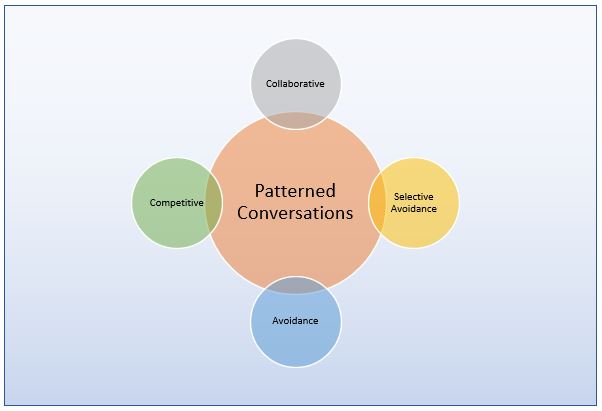Introduction:
At Mindful OD Practice, the focus is on helping organizations instill a culture of collaboration. The theme of the practice ‘Strengthen the Core’ refers to three core organization muscles that are instrumental in achieving a culture of collaboration – (i) Practice of participative leadership; (ii) Clear sense of direction; and (iii) Ongoing attention to culture alignment. Strengthening the core muscles enriches connections, commitment, coordination, learning, bench strength, and endurance. It promotes talent retention, creativity, responsiveness to change, and superior performance.
Within each of the three core muscles, there are a number of topics or routines that I plan to write about and share in my blog posts. The first is a topic that falls primarily under the practice of participative leadership. It emphasizes looking into the patterned conversations on how differing perspectives or differences are expressed, worked through, and concluded, and the implication it has for achieving collaboration. The writeup covers a definition of patterned conversations, the three common patterns, their source, and implications. The blog ends with a recommendation of a generic pattern that is suitable for a culture of collaboration.
Patterned Conversations, Common Patterns, Sources, and Implications
Conversations are the way members interact with one another in situations as they are being addressed. In this writeup, I am going to focus on conversations around situations that have differing perspectives or differences in viewpoints that if shared and worked through, produce positive outcomes. Oftentimes, expression of differing perspectives creates disagreements that are left unresolved leaving participants distressed and demotivated.
Patterned conversations are established over time guided by norms and beliefs rooted in culture and reinforced through leadership behaviors and other formal and informal mechanisms within the system. Below, I list examples of two sets of operational norms that are drawn from two very different organizational cultures. I also list the patterned conversations they create and resulting implications.
Operational norms that shape the conversation in a top-down authoritarian culture:
- Expression of ideas is risky
- Differing ideas are either not acknowledged or shot down
- Taking risks can hurt
- Expression of disagreements create tension and hostility
- Giving-in is losing; Win at all cost
- Keep armor on – cannot be vulnerable
These operational norms shape two common forms of conversation patterns:
- A Competitive Pattern: Where differences are belittled and members are suspicious of one another.
- An Avoidance Pattern: Where differences are evaded and members are withdrawn from the selectively withdrawn or completely withdrawn from conversations to minimize risks, disagreements, or causing hurt that is not attended to.
Either conversation pattern is characterized by lack of initiative, withholding of ideas, avoidance of disagreements, lack of trust, and low levels of engagement. Not a single one of these outcomes contribute towards achieving a culture of collaboration; they in fact are a hindrance.
Operational norms that shape the conversations in a collaborative culture:
- Expression of ideas encouraged; ask questions, explore, understand
- Ideas expressed are listened to
- Acquired courage to take risks
- Vulnerability promotes growth
- Disagreements are brought out in the open, addressed, and resolved
- Giving-in is about being flexible, learning, growing, and working together
These operational norms shape a Collaborative Pattern of conversation. It is characterized by active listening, asking questions, seeking to understand, initiative, trust, courage, learning, connections, participation across levels, seeking mutual benefit, with support for outcomes. Each of these outcomes are building blocks that nurture and reinforce a culture of collaboration.
To Achieve A Culture Of Collaboration, Raise Awareness Of Prevailing Patterned Conversations And The Transition
The type of interventions needed to bring about the desired conversation patterns to life will depend on the prevailing operational norms and how removed they are from the desired state. The transition initiative benefits most from increased awareness of patterns, desire to change, skills, coaching, and supportive behaviors that are modeled by senior leadership and management.
I emphasize the importance of understanding conversation patterns in situations where multiple perspectives exist and there is increased likelihood of disagreements, because that is where conversation patterns become more visible. I also emphasize looking into conversation patterns as a prelude to culture change because conversations are axial to every culture alignment decision. If the conversations continue to follow prevailing patterns, e.g., competitiveness or avoidance, attempts to bring about a culture of collaboration will be restrictive, at best.
When open and collaborative conversation patterns can be demonstrated in action, and members witness and experience the change in patterned conversations, they are energized, engaged, committed, speak up, and become connected at a new level, contributing to an enriched culture of collaboration.
——
Please let me know how you see the concept of patterned conversations around addressing the expression of differing perspectives? Do you see it as an important factor in influencing success with instilling a culture of collaboration? Please share your thoughts and/or observations from experience.


